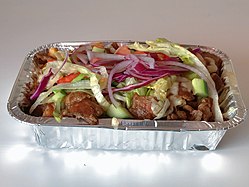Kapsalon
 A serving of Dutch Kapsalon | |
| Type | Fast food |
|---|---|
| Place of origin | Netherlands |
| Region or state | Rotterdam |
| Created by | Nataniël ”Tati” Gomes |
| Main ingredients | fries, meat (döner or gyro), Gouda cheese, salad vegetables |
Kapsalon (Dutch pronunciation: [ˈkɑpsaːˌlɔn] ) is a fast food dish created in 2003 in the Netherlands. It consists of a layer of french fries placed into a disposable metal take-away tray, topped with döner or gyro meat, covered with slices of Gouda cheese, and heated in an oven until the cheese melts. Then a layer of shredded iceberg lettuce is added, dressed with garlic sauce and sambal, a hot sauce from Indonesia, a former Dutch colony.[1] The term kapsalon is Dutch for "hairdressing salon" or barber shop, alluding to the inventor's place of work.[2] The dish is a product of Dutch multiculturalism, combining elements of dishes from multiple cultures. The dish has spread internationally in a relatively short time.[1]
Invention and spread
[edit]| External videos | |
|---|---|
The dish was conceived in 2003 by Nataniël Gomes, who was a Cape Verdean hairdresser in the Rotterdam district of Delfshaven, who one day at the neighboring shawarma store "El Aviva" asked to combine all his favorite ingredients into one dish. He began to regularly request what the restaurant called "the usual order for the kapsalon". Other customers noticed and started to order the kapsalon too, and it became a hit, soon being demanded in nearby snack bars.[1][3] Gomes reached a measure of international popularity; he died in 2023, aged 47.[4] The dish has since spread around the Netherlands and into Belgium,[5] and several other countries in at least three continents.[6] In some places the shawarma meat may be replaced with chicken, or doner kebab meat. The kapsalon has been described as "a typical example of contemporary cultural heritage", and "representative of the transnational nature of the city".[1][7] It has also been described as a "calorie bomb" and "culinary lethal weapon", with high fat content and up to 1,800 kilocalories (7,500 kJ) in a large serving.[3][1]
Kapsalon is a standard menu item in Belgian döner restaurants, both in Flanders and Wallonia. Various Turkish restaurants throughout Germany serve the dish, especially in larger cities.[6] The dish can be found in other cities throughout Europe as well, most Polish towns and cities (including Warsaw, Poznań and Kraków), in Prague, Czech Republic,[6] cities in Latvia (including Riga, Jelgava, Jūrmala, Sigulda)[8][9] in Oulu, Finland.[10] It has been found in Morocco and Cardiff in Wales as well.[6][11]
The kapsalon reached the Nepalese capital city of Kathmandu in 2017, when a chef returning from a visit to the Netherlands was asked to prepare a "typically Dutch" meal. Now chicken or fish replace the shawarma meat, and a porcelain plate substitutes for the metal tray, but the kapsalon has become fashionable, with many people posting photos and a prominent food blogger describing the dish as "a party in her mouth with her favorite tastes".[12] In Vientiane, Laos, similar adaptations of the kapsalon have emerged, featuring alternatives such as tuna and beef to accommodate local culinary preferences.[13]
-
People sharing a kapsalon
-
El-Aviva, where the kapsalon was created
See also
[edit]- Carne asada fries – Dish originating from San Diego
- Chorrillana – Chilean dish
- Halal snack pack – Australian halal dish
- Mitraillette – Belgian sandwich
- Poutine – Dish of french fries, cheese curds and gravy
- Yaroa – Dominican street food
References
[edit]- ^ a b c d e Sterre Lindhout (14 September 2011). "Culinair moordwapen" [Culinary lethal weapon]. Volkskrant (in Dutch).
- ^ Lester Haines (7 October 2011). "Post-pub nosh deathmatch: Kapsalon v quesadillas". The Register.
- ^ a b "Caloriebom Kapsalon: erg lekker!" [Caloric bomb Kapsalon: very tasty!] (in Dutch). Algemeen Dagblad. 23 August 2006. Archived from the original on 30 June 2015.
- ^ "Bedenker van de 'kapsalon' op 47-jarige leeftijd overleden" (in Dutch). NOS. 16 July 2023. Retrieved 16 July 2023.
- ^ "Nieuwste kebabhit 'het kapsalon' verovert Vlaanderen" [Newest kebab-hit 'Kapsalon' conquers Flanders]. vandaag.be (in Dutch). 21 December 2011. Archived from the original on 15 January 2012.
- ^ a b c d Jelmer Visser (23 August 2018). "'Oerhollandse' snack kapsalon verovert de wereld" ["Traditionally Dutch" snack kapsalon conquers the world]. metronieuws.nl (in Dutch). Archived from the original on 2 November 2021.
- ^ Leo Roubos (14 September 2011). "Kapsalon is cultureel erfgoed van toekomst" [Kapsalon is cultural heritage of the future]. RTV Rijnmond (in Dutch).
- ^ "KAPSALONS". Lemongrass (in Latvian). Retrieved 16 November 2022.
- ^ "Kebabfactory". sigulda.kebabfactory.lv. Retrieved 16 November 2022.
- ^ "Lekker61". lekker61oulu.com (in Finnish). Retrieved 31 August 2023.
- ^ Gilbert, Ed (21 February 2022). "The best chips you can eat in Cardiff right now". Wales Online. Retrieved 6 January 2024.
- ^ Wesley Schouwenaars (8 November 2017). "Kapsalon is 'een feestje' in Nepalese mond" [Kapsalon is "a party" in Nepalese mouths]. BNR.nl (in Dutch).
- ^ Rolf Eijgenraam (17 October 2018). "Kapsalon zelfs in Laos te eten" [Kapsalon can even be eaten in Laos]. AD.nl (in Dutch).
External links
[edit] Media related to Kapsalon (food) at Wikimedia Commons
Media related to Kapsalon (food) at Wikimedia Commons




